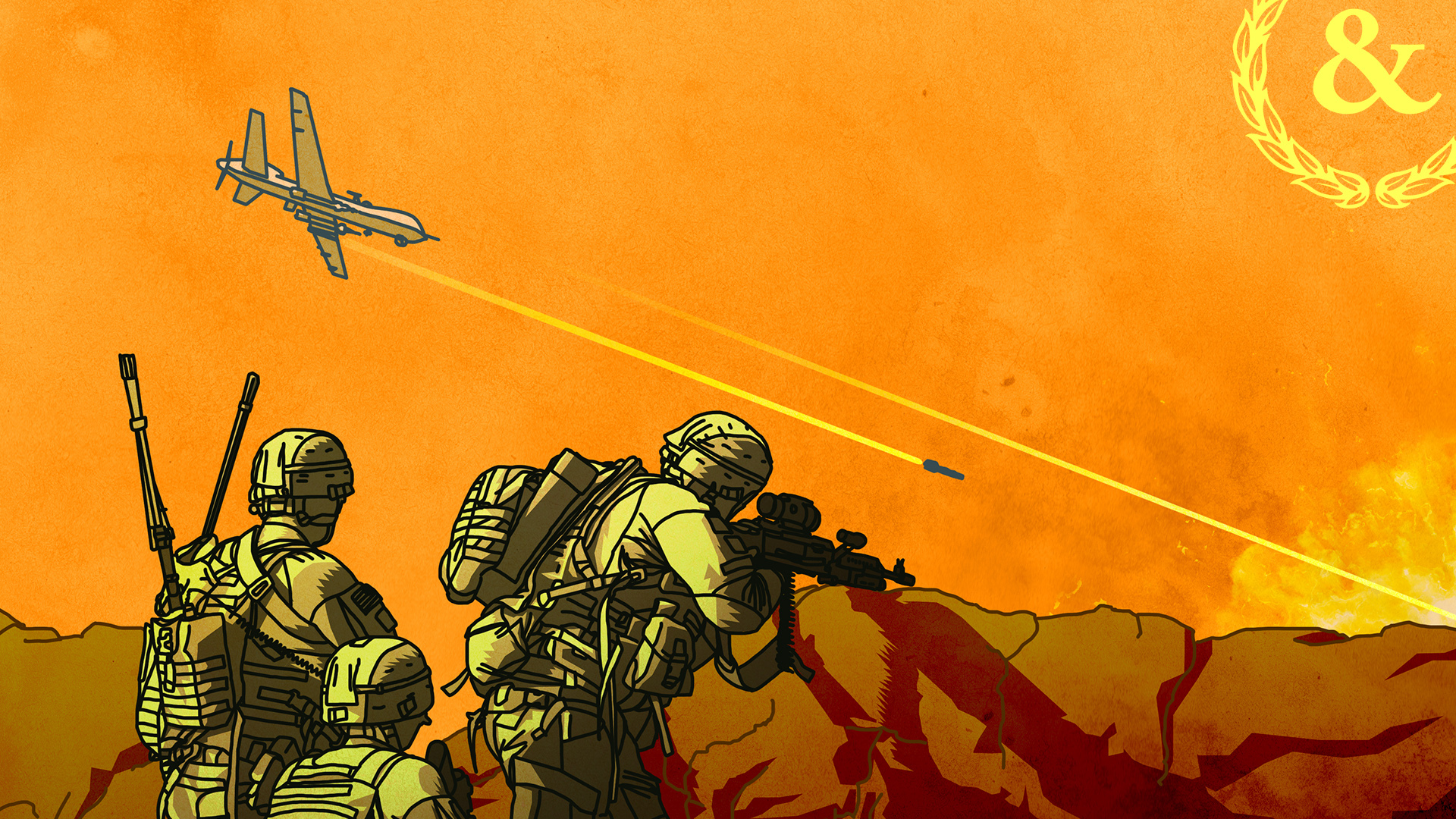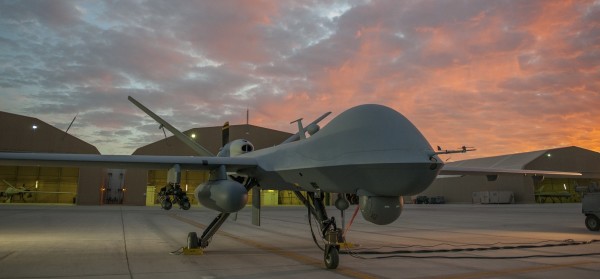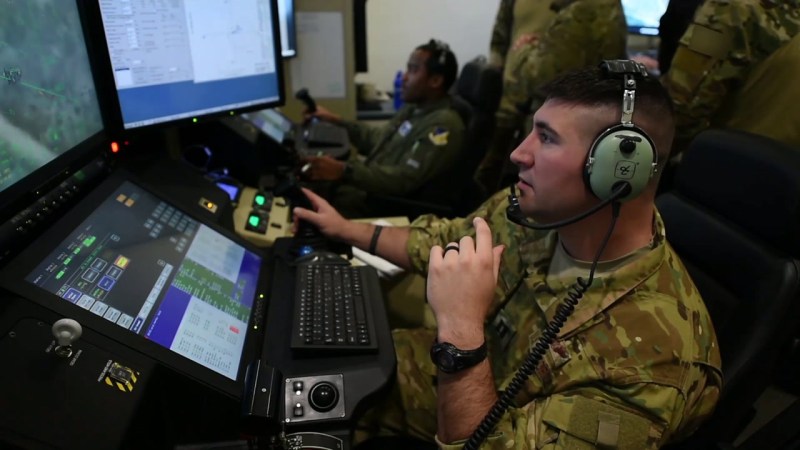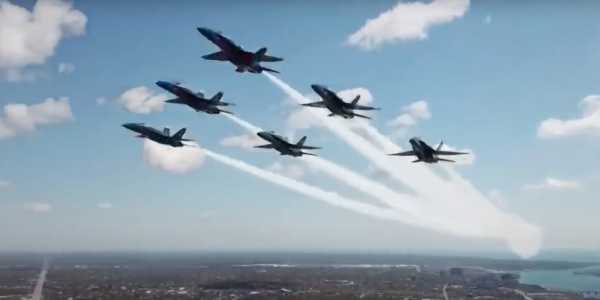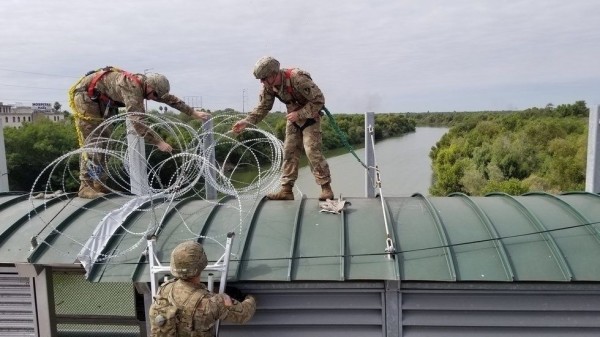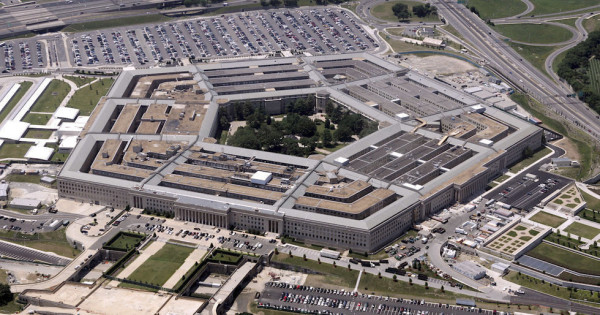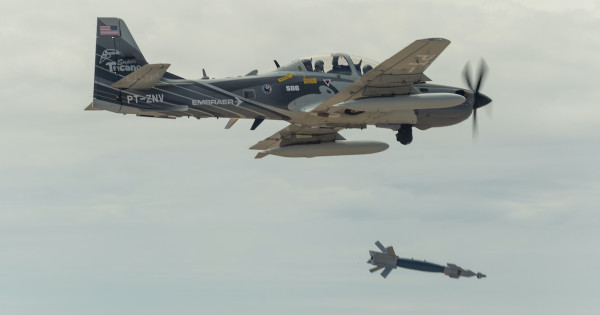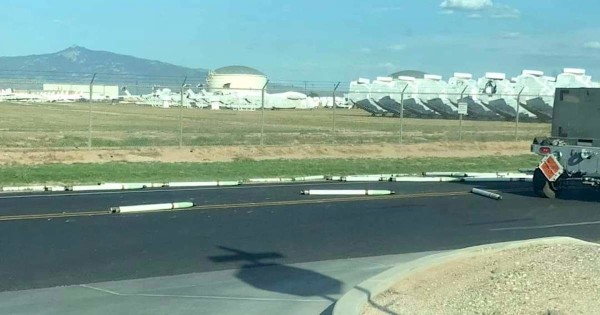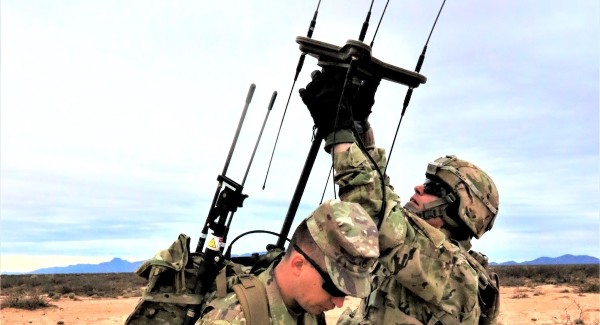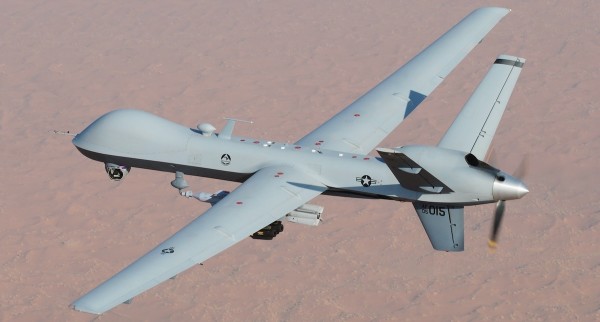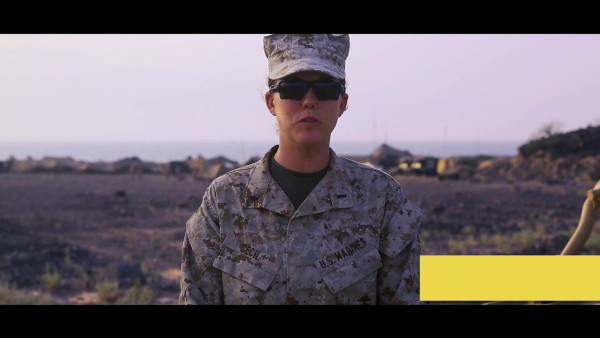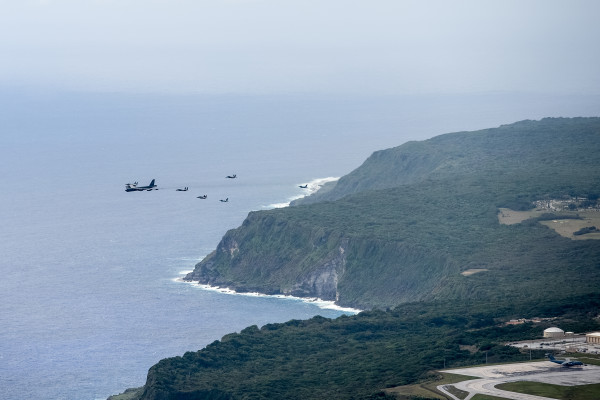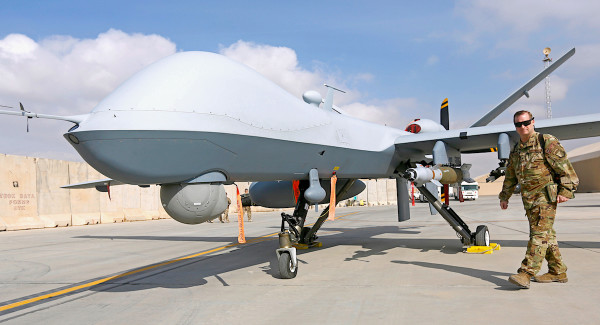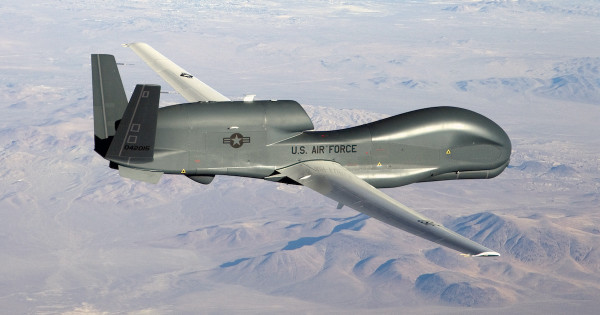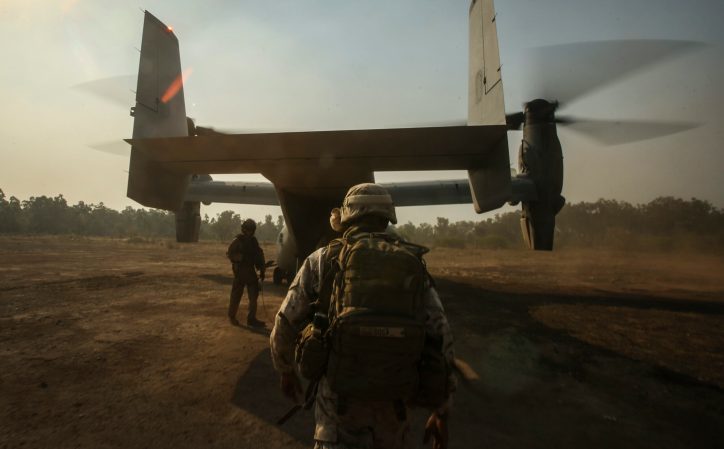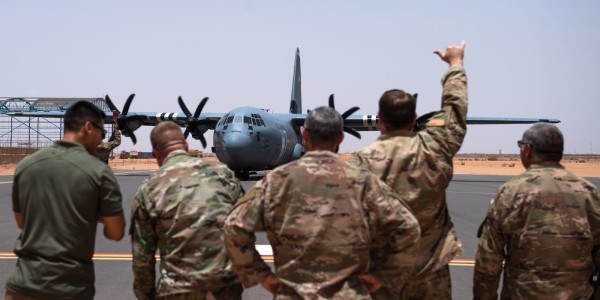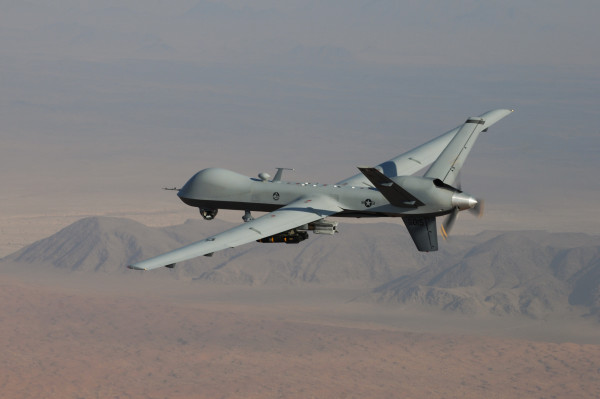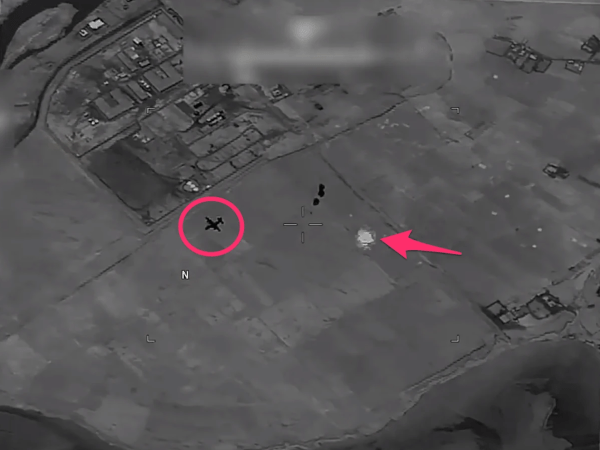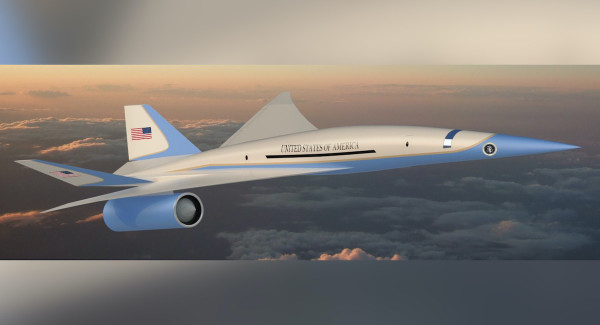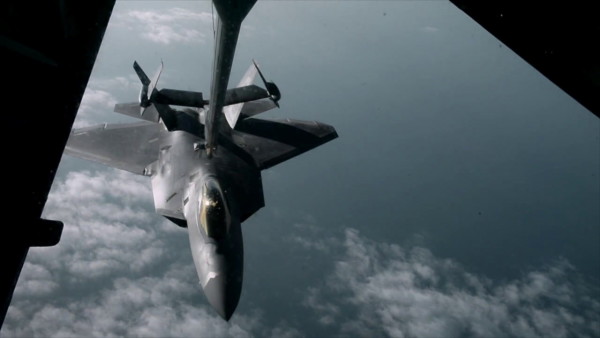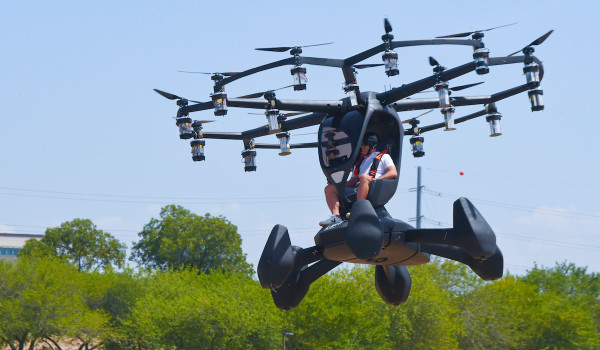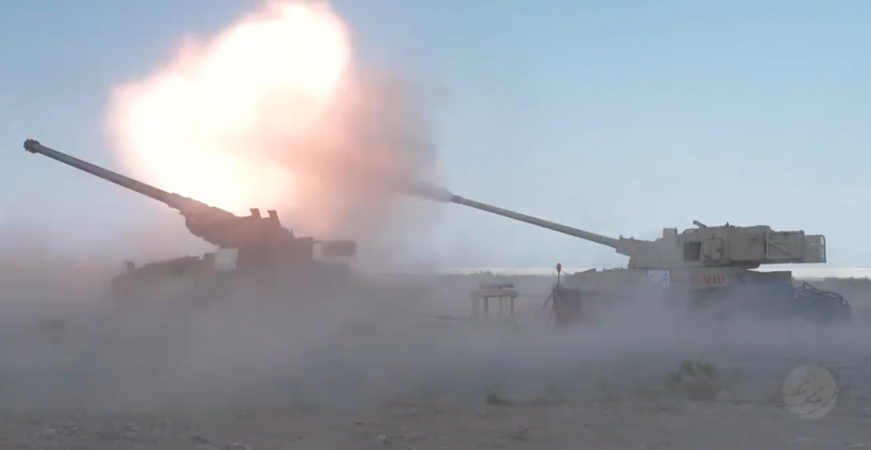Back when this reporter was a high schooler volunteering at Antietam National Battlefield, he heard a park ranger once say that many visitors asked whether modern weaponry like a machine gun or a tank would have made a difference in the Civil War. While those would have undoubtedly helped whichever army wielded it, he said, a more humble bit of modern tech would have been a game-changer. What would have really made a difference on a confusing, gunsmoke-covered 19th-century battlefield, the ranger said, was a walkie-talkie.
Sometimes it’s not the weapons that win battles, but the tools troops use to see, hear and communicate about what’s going on. That seems to ring true today, where the Air Force risked sending a multi-million dollar aircraft over 9,000 miles of open ocean to prove it could serve both as a persistent source of targeting and sensor information and also relay that information to service members throughout the Pacific in a possible war against China.
In doing so, one Air Force officer with over a decade of experience in operations said that the aircraft, an MQ-9 Reaper drone from Creech Air Force Base, Nevada, proved it’s not just a relic of the Global War on Terror. Instead, it can serve as a cheap and effective tool for service members to get the information they need to win future battles, especially for the ground-pounders who would likely face some of the toughest conditions on the way.
“The Marines want these things for rapid detection, location, and characterization of enemy forces in order to protect the force,” said the Air Force officer, who preferred to stay anonymous since he is still actively serving. “Sure, they could use them to lob Hellfire missiles, but that’s not nearly as helpful as using them to create a persistent, coherent, and accurate picture of the battlespace, especially when they’re on the move in vast but dangerous combat arenas.”

Marines themselves have repeatedly articulated that need in the past.
“The Marine Corps is currently the scrappy, blind fighter eager to open its eyes,” wrote Marine infantry officers Lt. Col. Scott Cuomo and Capt. Jeff Cummings, and Marine unmanned aircraft officers Capt. Olivia Garard (who has since separated from the military) and Col. Noah Spataro, in a 2017 essay for War On the Rocks.
Subscribe to Task & Purpose Today. Get the latest military news, entertainment, and gear in your inbox daily.
To open those eyes, the Marines called for a ‘Guardian Angel,’ (also called a ‘Grunt Angel’ by one Marine), that could stay aloft way longer than human pilots; provide secure communications with other service members; fire close-in precision strikes; interfere with enemy communications; serve as a look-out over a wide area; help coordinate fire support from other platforms; and be able to take off and land from small, undeveloped airfields in the middle of nowhere. What aircraft does the U.S. military already have that can perform all of those tasks? The Reaper.
“Having the Reaper on-station was the most important thing,” said one Marine infantry captain who fought in Sangin District, Afghanistan, according to a separate essay written by Cuomo. “It is something we need right now … we would not have been successful without it, hands down.”
Though the Marine Corps is now experimenting with a host of low-cost drones that may become part of a typical infantry squad load-out, the Reaper proved it still has a part to play during its trip over the Pacific this June. The trip was a part of Valiant Shield 2022, where the military frequently tests technologies through integration between the services, the Air Force explained in a press release. The Creech-based 556th Test and Evaluation Squadron wanted to see if the Reaper could help speed up how quickly a joint operation can find a target, fix its location, track it, target it, engage it with a weapon, and assess the results – a process bigwig military planners often call “‘the kill chain.”
Reapers closed plenty of kill chains over Iraq, Afghanistan and other countries during the Global War On Terror. The drone first entered service in 2007 and was soon performing intelligence, surveillance, and reconnaissance missions over the deserts and cities of the Middle East and Southwest Asia. Its long 66-foot wingspan allows the drone to loiter for up to 30 hours and carry a wide range of weapons and sensors to do anything from convoy overwatch to bombing terrorist leaders. In 2015 and 2016, Reapers were part of the ‘kill-chain’ for 50,501 out of 61,723 airstrikes across U.S. Central Command, which oversees the Middle East and Southwest Asia.

“In other words, just over 81 percent of the time the U.S. Air Force attacked, its enemies had been under a Reaper’s crosshairs,” a half-dozen military experts wrote in a 2018 essay.
Not all of the Reaper’s legacy is pretty: over the past 20 years, the drone and others like it have been involved in the deaths of hundreds of civilians in miscalculated or accidental strikes, including seven children in a strike in Kabul last August. Still, many military planners and experts believe the drone could play a significant role as an eye in the sky against potential adversaries like China or Russia. The 556 TES wanted to see if the drone could fill that role over the vast reaches of the Pacific, without the sprawling support bases that the American military is used to around the world.
“We proved out what we could do by just going up there and just flying the plane to a location that we’ve never operated from,” the squadron commander, Lt. Col. Michael Chmielewski, told Air Force Magazine. “There’s this monumental change in mindset, that I don’t need to pack all this stuff up and go. I can go places just with a very small piece of maintenance equipment and less amount of people.”
Indeed, unlike most Reaper operations, the pilots and enlisted sensor operators back at Creech controlled the drones the entire time despite being half a world away. Usually, Reapers are controlled from the continental U.S. during flight, while take-off and landing are controlled by crews in-theater. However, in Valiant Shield, the MQ-9 showed off new software which allows it to take off and land all by itself.
“The Reaper is the only aircraft I’m aware of that can fly by a location it has never landed at, use the camera to conduct a survey of the runway in real-time, and build a 3D model in its memory to enable automatic takeoff and landing operations,” the anonymous Air Force officer said.

The advantage of landing without a ground crew is that the military needs fewer people to fly out to a random island, feed and protect in order to sustain the Reaper mission. “Skeleton crew” seemed to be the modus operandi for the entire 556 TES exercise during Valiant Shield 2022. The MQ-9 team managed to set up operations on the remote island of Palau with just 10 people and 1.5 pallets of equipment, according to the press release.
That kind of footprint, which can fit on an aircraft as small as a C-130 turboprop transport plane or a V-22 Osprey, is basically nothing compared to the footprint of most manned aircraft. For example, a typical manned fighter jet would require more than 10 times as many people and five to 10 times as many large cargo aircraft, like a C-17 jet, the anonymous Air Force officer said. The light footprint of the Reaper also means that the ground crew can pack up and move to a new location extremely quickly. For example, when the Reaper took off from Palau for the last time during Valiant Shield 2022, the ground crew and equipment boarded a C-17, flew about 800 miles to Guam, then landed in time to welcome the same MQ-9 when it returned from its sortie.
“With a platform like this, you know, we’ll set up shop for a week, run ops for a week from our location with reduced footprint, and then go back,” Chmielewski told Air Force Magazine. “Take your smaller footprint, put that forward in a different location, then go persist there for however long you want to persist.”
Having a smaller footprint does not just allow for faster movement; it also complicates the enemy targeting process by presenting a smaller target, thereby making it not as tempting as a large facility like Andersen Air Base in Guam might be. The commander told Air Force Magazine that usually it takes 55 maintainers three to four days of prep to break down the Reapers, ship them on C-17s, reassemble them down-range and set up the antenna control towers that serve as cockpits for the drones. But now that the Reaper can take off and land all by itself, it takes far fewer people and equipment to do the job.
The Reaper’s small footprint lines up perfectly with the “Grunt Angel” wishlist laid out by Marine officers in War On the Rocks and other publications. The Marine Corps’ defining capability is “the expeditionary nature,” of the Marine Air-Ground Task Force, Cuomo, Cummings, Garard and Spataro wrote in 2017. A “Grunt Angel,” therefore, could live up to its name only if it can also operate with the rest of the expeditionary force: up front, near the fighting and far from support.

Still, flying an aircraft from a cockpit in another hemisphere introduces a possible vulnerability: the satellites that link together the entire operation. Many military planners predict enemies such as China or Russia may try to disrupt U.S. satellite use in a conflict, so how will the Reaper keep flying without them? Well, in recent years, the Air Force has developed new systems for making its aircraft-satellite connection more resilient than usual. Efforts like Global Lightning allow the Air Force to put communication terminals on aircraft, where they can share data with satellites and associated ground terminals. According to the Army, commercial satellite constellations such as the 2,700 small satellites that make up SpaceX’s Starlink also provides users with “high-speed, low latency broadband internet across the globe.”
“The old military satellite communication system uses what’s called geosynchronous [satellites], which orbit around the equator at a steady pace, but it takes a little over half a second for the signal to travel up and back down,” an Army network technician named Chief Warrant Officer 3 Kyle Neese said in February. “With Starlink, it comes back at more than twice the speed.”
The sheer number of Starlink satellites in orbit also makes the network difficult to shut down by an adversary. Dave Tremper, the Pentagon’s director of electronic warfare, described Stalink’s resistance to Russian jamming attacks in Ukraine earlier this year as “eye-watering,” Breaking Defense reported. Though the 556 TES did not mention Starlink or Global Lightning in its press release, the Air Force may theoretically be able to install a communications terminal on the Reaper and hook it up to Starlink’s prodigious network, making the satellite connection more resilient than it would be otherwise.
“Starlink is also the only [low Earth orbit] satellite network provider that is currently being used in a contested environment: Ukraine,” the Air Force wrote in a contract for Starlink satellite services worth a little more than $1.9 million, as reported by Air Force Magazine.
When combined with resilient satellite links, it’s pretty tough to keep Reapers from flying, especially when compared with manned aircraft. At 90%, the MQ-9 enjoyed the highest mission readiness rate in the Air Force in fiscal year 2021, Air Force Times reported. The fighter fleets ranged between 50% and 70%, while several transport, refueling and training aircraft hit the 70% to upper-80% range. The F-35A had a 69% readiness rate at the time.
However, the “full-mission capable” rate, which measures an aircraft’s ability to perform the entire range of its missions, tells a different story. The Government Accountability Office reported in 2021 that the full mission capable rate for the Air Force’s F-35A in 2020 was 54%, while the Marine Corps’ F-35B stood at 15.1%, and the Navy’s F-35C trailed at 6.8%. But manned aircraft are also more expensive than drones like the Reaper. Cuomo wrote in a separate essay that flying an F-35B for one hour costs $51,300, while the MQ-9’s per hour cost is $3,624, according to the Center for Strategic and International Studies. A manned aircraft may be able to loiter for only a handful of hours before having to refuel or land to rest the pilot, whereas the Reaper can loiter for up to 30 hours.
“Marines on the ground love their pilots and the support they bring, but they can only stay overhead for a short time before the realities of fuel and sleep leave the infantry vulnerable from the sky,” wrote Capt. Ben Brewster, a Marine infantry officer, in a 2017 essay for War On the Rocks. “The Reaper is the only immediately available solution, and the only realistic one for the next decade or more.”

Individual Marine officers are not the only ones heaping praise on the Reaper. The Commandant himself, Gen. David Berger, took to Twitter to praise Marines at Twentynine Palms, California who refueled an Air National Guard MQ-9 by hooking it up to an MV-22 earlier this summer.
“From a warfighting perspective, this is important,” Berger tweeted recently. “The USMC is working hard to adapt the MQ-9 to smaller footprints and support the Joint Force as the Stand-in Force.” The Marine Corps defines the stand-in force as “small but lethal … relatively simple to maintain” mobile forces that can hang out around a potential conflict zone, fight when conflict erupts, then quickly transition back to a holding pattern. The Reaper, with its long loiter times and ability to launch precision-guided munitions, seems built for that kind of work.
“We need to establish an MQ-9 squadron in Hawaii that can then push the [intelligence, surveillance and reconnaissance] coverage more towards China,” Berger told Congress in May, where he announced the Marines’ intention to build their own Reaper squadron, according to FedScoop.

When asked if platforms such as the Reaper can help Marines on the ground in the Indo-Pacific executing operations envisioned in the stand-in forces concept and more traditional crisis response missions, such as embassy reinforcement, embassy evacuation, or long-range raids, Cuomo responded, “Absolutely, and we’re already seeing aspects of these realities play out, such as in the recent Valiant Shield and RIMPAC successes.” RIMPAC, a.k.a. Rim of the Pacific, is a large international maritime warfare exercise where this year the MQ-9 made its first appearance and even helped sink an old frigate.
Cuomo pointed out that Japan, a key U.S. ally in the Pacific, is also looking into cheap, reliable, long-endurance drones. Japan, Australia, Taiwan and India are buying or are considering buying MQ-9B SeaGuardians, which are designed for working in maritime environments. On top of the MQ-9 family’s already lengthy list of mission sets, tests in 2021 showed that the drone can also drop buoys to detect enemy submarines, The War Zone reported. If all these MQ-9-operating countries work together, the drones may have the effect of deterrence by detection against China or other actors. ‘Deterrence by detection’ is a concept where nations use “a network of existing non-stealthy long-endurance unmanned aircraft systems to maintain real-time, persistent situational awareness in key geographic areas in the Western Pacific and Eastern Europe,” wrote analysts in a 2020 paper for the Center for Strategic and Budgetary Assessments.
The Marine Corps’ plans, the 556 TES experiment and the work of Pacific allies stand out at a time when the Air Force seems largely intent on retiring the Reaper by the 2030s. In November, a retired Air Force general even wrote a widely-read paper reminding the branch of the drone’s wide application, high readiness rate and low operating cost.
“The Reaper can be used in many new ways to include wide-area surveillance, air and missile defense, maritime and littoral operations, Arctic domain awareness, cruise missile defense of the homeland, and even defense support of civil authorities,” wrote retired Air Force Maj. Gen. Lawrence Stutzriem in a paper for the Mitchell Institute for Aerospace Studies.
“Considering these mission sets and the affordability of adapting the weapon system, the MQ-9 is one of the Air Force’s most relevant aircraft,” he added. “The Reaper must be reimagined, not prematurely retired.”

Against that backdrop, the anonymous Air Force officer was surprised the 556 TES experiment even got off the ground.
“I think it’s a miracle that the 556 Test and Evaluation Squadron was able to get this story out at all,” he said. “Headquarters Air Force believes, and it needs Congress and the public to believe, that the aircraft is a relic of counterterrorism operations.”
Instead, Valiant Shield seems to prove that the Reaper can perform a vital role in integrating U.S. forces far from home. The cherry on top seems to be the Electronic Support Measure pod which the Reaper used for the first time during the exercise. According to the press release, the ESM pod allowed the Reaper to push out data across the theater, putting far-flung service members on the same page.
“The ESM pod proved its ability to give the MQ-9 an all-weather, long-range sensor capable of finding, fixing, and tracking targets of interest to enhance situational awareness and provide actionable targeting solutions as part of the Joint kill chain,” said Chmielewski, the squadron commander.
It’s not just ground forces who benefit. Air Force Magazine reported that the ESM also provided combat jets with targeting data, and at one point the Reaper switched its radar to maritime mode to scan for enemy ships and relay that data to a carrier strike group. It may not be as stealthy as an F-35 fighter or as fast as an F-15, but it seems the military still has benefits to reap from the Reaper.
“Marines need a Grunt-Angel,” wrote Brewster. “The MQ-9 Reaper is the only existing platform that can do it.”
The latest on Task & Purpose
- Why nobody wants to be a battalion commander in the Army Reserve
- The Army has a drone flying over the American Southwest that refuses to die
- We salute the soldiers who named their tank ‘Article 15’
- This little-known Air Force jet just became the most-watched aircraft in history
- Here’s what all those UFO sightings might be — and what the military may know
Want to write for Task & Purpose? Click here. Or check out the latest stories on our homepage.

